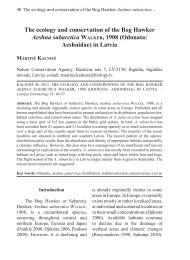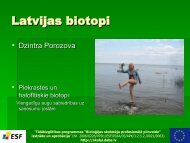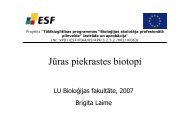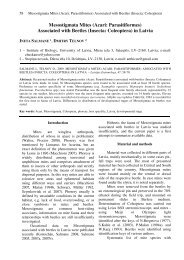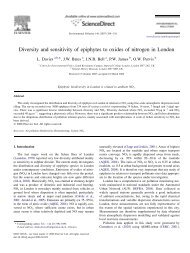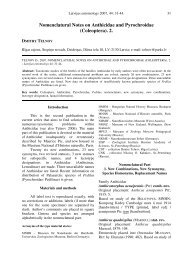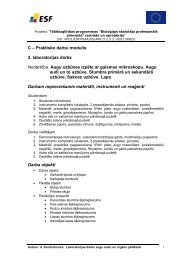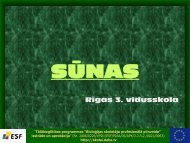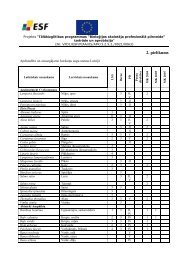Synthesis <strong>of</strong> New Solvatochromic Dyes by Reduction <strong>of</strong> BenzanthroneAzometh<strong>in</strong>esI.D.Ivanova 1 , N.V.Orlova 1 , E.M.Kirilova 21 Faculty <strong>of</strong> Chemistry, University <strong>of</strong> Latvia, 48 Valdemara str., LV-1013, Riga (Latvia);2 Chemistry Department, Daugavpils University, 13 Vienibas str., LV-5401, Daugavpils(Latvia).Many derivatives <strong>of</strong> benzo[de]anthracene-7-one exhibit strong emission, which accountsfor their use <strong>in</strong> practice as active las<strong>in</strong>g media and fluorescent probes for <strong>in</strong>vestigation <strong>of</strong>biological objects. In present work a number <strong>of</strong> new derivatives <strong>of</strong> 3-am<strong>in</strong>obenzanthronewere synthesized. In summary, ten new dyes were synthesized <strong>in</strong> good yields (80-87%)via the reduction <strong>of</strong> correspond<strong>in</strong>g azometh<strong>in</strong>e derivative by sodium borohydride <strong>in</strong> DMFsolutions.The structure <strong>of</strong> obta<strong>in</strong>ed compounds was confirmed by NMR and FT-IR spectroscopyand mass spectrometry. S<strong>in</strong>gle-crystal structures <strong>of</strong> obta<strong>in</strong>ed dyes were determ<strong>in</strong>ed by X-ray diffraction studies. In addition, thermal stability <strong>of</strong> the synthesized chromophores hasbeen undertaken us<strong>in</strong>g TG–DTA. The <strong>in</strong>fluence <strong>of</strong> solvents with various polarities uponabsorption and emission spectra was <strong>in</strong>vestigated. The absorption and lum<strong>in</strong>escent spectra<strong>of</strong> the novel compounds <strong>in</strong> several solvents <strong>of</strong> different polarity were <strong>in</strong>vestigated. Thesynthesized dyes absorb at 520-580 nm with high ext<strong>in</strong>ction coefficients, have relativelylarge Stokes’ shifts (about 100 nm), and emit at 650-720 nm show<strong>in</strong>g both absorption andfluorescence solvatochromism similarly to studied earlier 3-am<strong>in</strong>o derivatives <strong>of</strong>benzanthrone [1,2]. The results <strong>in</strong>dicated that these dyes were strongly dependent onsolvents and show generally bathochromic shifts as the polarity <strong>of</strong> solvents was <strong>in</strong>creased.These characteristics <strong>of</strong> obta<strong>in</strong>ed dyes demonstrate their potential as biomedical probesfor prote<strong>in</strong>s, lipids and cells.1. Kirilova, E. M; Kaln<strong>in</strong>a, I; Kirilov, G. K; Meirovics, I. J. Fluoresc 2008, 18 (3-4), 645-648.2. Gorbenko, G.; Trusova, V.; Kirilova, E.; Kirilov, G.; Kaln<strong>in</strong>a, I.; Vasilev, A.; Kaloyanova, S.;Deligeorgiev, T. Chem. Phys. Lett, 2010, 495, 275–279.- 10 -
Novel Heterocyclic Im<strong>in</strong>o and Am<strong>in</strong>o Derivatives <strong>of</strong> Benzanthrone:Synthesis and PropertiesI.D Ivanova 1 , N.V.Orlova 1 , A.I .Puchk<strong>in</strong> 2 , E.M.Kirilova 21 Faculty <strong>of</strong> Chemistry, University <strong>of</strong> Latvia, 48 Valdemara str., LV-1013, Riga (Latvia);2 Chemistry Department, Daugavpils University, 13 Vienibas str., LV-5401, Daugavpils(Latvia).e-mail: elena.kirilova@<strong>in</strong>box.lvThe design <strong>of</strong> new fluorescent molecules is <strong>of</strong> cont<strong>in</strong>u<strong>in</strong>g <strong>in</strong>terest for many applications <strong>in</strong>research and <strong>in</strong>dustry. Especially donor–acceptor -conjugated <strong>organic</strong> materials haveattracted considerable <strong>in</strong>terests ow<strong>in</strong>g to their potential wide applications for development<strong>of</strong> photoactive materials. Many derivatives <strong>of</strong> benzo[de]anthracene-7-one are known aseffective lum<strong>in</strong>escent dyes with emission <strong>in</strong> the spectral region from green to red-purple,depend<strong>in</strong>g on the structure [1].Recently we reported the synthesis, molecular structures and spectral properties <strong>of</strong> a series<strong>of</strong> am<strong>in</strong>o, amid<strong>in</strong>o, and im<strong>in</strong>obenzanthrones, which appeared to be particularly <strong>in</strong>terest<strong>in</strong>gbecause they lead to perspective lum<strong>in</strong>escent materials [1]. The aim <strong>of</strong> this work is tocreate a series <strong>of</strong> benzanthrone am<strong>in</strong>es and azometh<strong>in</strong>es by <strong>in</strong>clud<strong>in</strong>g new heterocyclicsubstituents <strong>in</strong> benzanthrone chromophoric system <strong>in</strong> order to f<strong>in</strong>d novel lum<strong>in</strong>ophoreswith large lum<strong>in</strong>escence <strong>in</strong>tensity and high stability.Target benzanthrone derivatives are synthesized by condensation reaction <strong>of</strong>correspond<strong>in</strong>g am<strong>in</strong>obenzanthrone with appropriate heterocyclic aldehydes with follow<strong>in</strong>greduction <strong>of</strong> obta<strong>in</strong>ed im<strong>in</strong>es by NaBH 4 <strong>in</strong> DMF solution:R:NH 2ROHNRNaBH 4, DMFHNRNNNNOOO1 2a-g 3a-gSynthesized derivatives have bright from yellow to red fluorescence <strong>in</strong> <strong>organic</strong> solventsand solid state. The structure <strong>of</strong> obta<strong>in</strong>ed compounds was confirmed by NMR, IR andmass spectroscopy. In addition thermal properties and crystal structures <strong>of</strong> preparedcompounds have been <strong>in</strong>vestigated.1. B.M. Krasovitskii, B.M. Bolot<strong>in</strong>, Organic lum<strong>in</strong>escent materials. - VCH Publishers, 19882. E. M Kirilova, I. Kaln<strong>in</strong>a, G. K. Kirilov, S. V Belyakov, I. Meirovics. Spectroscopic Study <strong>of</strong>Benzanthrone 3-N-Derivatives as New Hydrophobic Fluorescent Probes for Biomolecules//J.Fluoresc. – 2008 - Vol. 18 (3-4) – P.645-6483. V.M Trusova, E. Kirilova, I. Kaln<strong>in</strong>a, G. Kirilov, O.A. Zhytniakivska, P.V. Fedorov, G.Gorbenko, Novel Benzanthrone Am<strong>in</strong>oderivatives for Membrane Studies.// J.Fluoresc.- 2012 -Vol. 22 (3) – P.953-959OSN- 11 -




